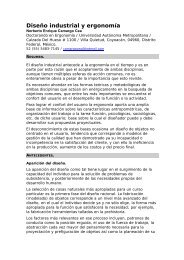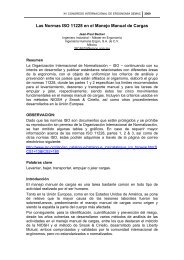ERGONOMÍA OCUPACIONAL - SOCIEDAD DE ERGONOMISTAS ...
ERGONOMÍA OCUPACIONAL - SOCIEDAD DE ERGONOMISTAS ...
ERGONOMÍA OCUPACIONAL - SOCIEDAD DE ERGONOMISTAS ...
Create successful ePaper yourself
Turn your PDF publications into a flip-book with our unique Google optimized e-Paper software.
Ergonomía Ocupacional. Investigaciones y Aplicaciones. Vol 3 2010<br />
4. Discussion<br />
In an implicit form the purpose of this research was to show how force depend on anthropometric<br />
characteristics and how force is related with fatigue with a clear decrease pattern on force<br />
behavior trough hours and days.<br />
The first part tested by principal components and linear regression is positive; a statistical<br />
relationship does exist between hand and finger anthropometrics and force, in detail table 3 shows<br />
that, all values on above .600 on second group are related with the explanation of variance.<br />
In the second part the expected was that the greater values for hand forces were on the early hour<br />
and Monday, but results are not in that direction, for right hand force within hours, table 7 shows a<br />
difference only between the first hour of the test and 2.5 hours later. For left hand there is not<br />
statistical evidence that shows how force decrease in function of time.<br />
For hand force behavior related to day week, due to more than 90% of people are right-handed,<br />
the expected force behavior is that on Monday are the greater averages while on Friday should be<br />
the smaller averages. Table 12 shows that there is not any significative difference on right hand<br />
force average. For left hand force average, respect to Monday is valid a decreasing force behavior<br />
but statistically is valid only to Friday, on Tuesday the difference on average is only respect to<br />
Friday. The other days remain the same.<br />
As a final conclusion on this research the findings is that force has not a decreasing behavior due<br />
to hours or days, it makes necessary to increase the number of measurements and run a test for<br />
the thumb force.<br />
This fact, no decreasing force behavior should be not assumed as a fatigue free operations, while<br />
data were collected people says how at the end of the day they are with symptoms of pain and<br />
numbness on fingers, wrist, shoulder, neck and low back. Highly repetitive operations may have<br />
not an effect on force but that does not means that is an easy job.<br />
In maquilas, there is a lot of situations that should be improved, beyond manufacturing and quality<br />
is the human being, it is not only manpower, they are people and deserve a good place to<br />
workon.<br />
References<br />
Bernard, B. (1997). “Musculoskeletal Disorders and Workplace Factors; A Critical Review of<br />
Epidemiologic Evidence for Work-Related Musculoskeletal Disorders of the Neck, Upper<br />
Extremity, and Low Back”.Centers for Disease Control and Prevention, National Institute for<br />
Occupational Safety and Health (NIOSH).<br />
Sociedad de Ergonomistas de México, A.C. 65




